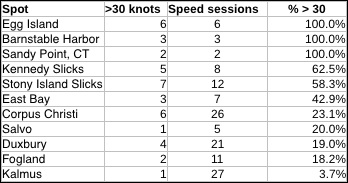But as the avid reader of this blog knows, my Kalmus sessions are usually freestyle or bump & jump sessions. It's rare that the wind is strong enough to make speed sailing interesting, and when that happens, I often sail upwind or downwind half a mile to the nearby slicks - Egg Island downwind, and the Kennedy Slicks upwind. If we look at only sessions where I used slalom gear, and then sort by the percentage of sessions where I did 30+ knots, a different image emerges:
Now, Sandy Point is on top, followed by Egg Island and two other slicks on Cape Cod. Of the spots on the list, I would indeed rank Sandy Point as the spot with the highest speed potential when wind, tide, and wind direction all come together. But that does not happen often; furthermore, Sandy Point requires a 3-hour drive, while all the other spots are a lots closer (with Salvo being a vacation spot, and Corpus Christi a winter spot). So we sail at Sandy Point only when we can be darn sure that it will be really windy!
The table above includes sessions with large slalom gear like my 117 l slalom board. When I use the large gear, the wind is typically around or below 15 knots, which makes is darn near impossible for me to reach 30 knots. To get a better idea of the "real quality" of the speed spots, let's look at only sessions on slalom boards below 100 liters:
Now, Egg Island and Barnstable Harbor jump to the top - two of my local favorites. Kennedy Slicks also looks better, with 5 out of 8 sessions above 30 knots. Overall, there are now five spots where sailed faster than 30 knots more than half of the time - cool! The four spots within a 45 minute drive work in a variety of different wind directions: SW-WSW, NW-NNW, and NNE-NE-ENE. You just have to know where to go...
Of the other spots, some indeed make it hard to go faster than 30 knots, at least at my skill level. But some spots are not quite as bad as they seem, for a variety of reasons. Of the 40 sessions that I hit 30 knots, I had wind gusts above 23 knots 38 times. But in Corpus Christi, only 10 of the 26 speed sessions had wind gusts above 23 knots; counting just these 10 sessions would give a much better ">30 knot percentage".
Fogland is another example of a spot that looks worse in the tables above than it really is. The first time I broke 30 knots was in November 2011; the next two 30-knot session were in early 2012 in... Fogland. But after we moved to Cape Cod in the summer of 2012, we stayed on Cape Cod, and went to Fogland only on rare occasions - usually for Dani's BBQ.
Have you ever played a multi-level video game where it took a while to get to the highest level, but once you got there, the lower levels seemed much easier? I think speedsurfing is similar: once you reached a certain speed, reaching what used to be your top speed before becomes much easier. This applies to many different speedsurfing categories: top speed, alpha 500, even the nautical mile. I have often seen speedsurfer "unlock" new speed levels, and afterwards post sessions where there numbers where much higher than they would have been before the "unlock" event. Sometimes, there's an obvious reason for the new "top level", like new gear; at other times, it's a trip to a much faster speed spot like the Lüderitz speed channel or La Franqui, or the opportunity to sail with better speedsurfers; and sometimes, there is no obvious reason. But whatever the cause was, reaching a new top speed level can definitely have an "unlock" effect. So go pick a spot and play a lot!


